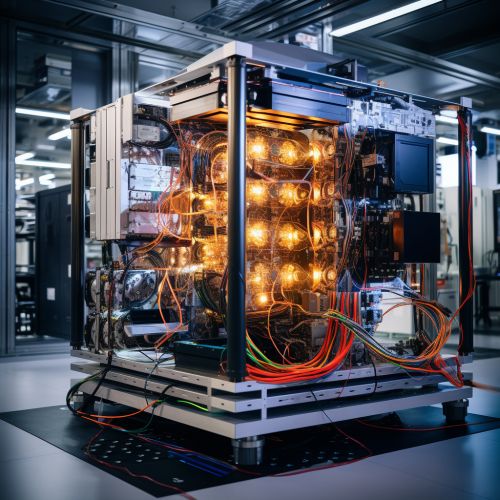Quantum Computing with Quantum Optomechanical Systems for Quantum Information Processing
Introduction
Quantum computing is a rapidly evolving field that leverages the principles of quantum mechanics to process information. This article focuses on the use of quantum optomechanical systems in quantum computing for quantum information processing.
Quantum Computing
Quantum computing is a type of computation that makes direct use of quantum-mechanical phenomena, such as superposition and entanglement, to perform operations on data. Quantum computers are different from binary digital electronic computers based on transistors. Whereas common digital computing requires that the data be encoded into binary digits (bits), each of which is always in one of two definite states (0 or 1), quantum computation uses quantum bits or 'qubits', which can be in superpositions of states.


Quantum Optomechanical Systems
Quantum optomechanical systems are physical systems in which the motion of a mechanical object is coupled to the state of a light field. This coupling can be achieved by a variety of mechanisms, including radiation pressure, electrostatic forces, and magnetic forces. The mechanical object, which can be anything from a tiny mirror to a vibrating membrane, interacts with the light in such a way that its motion can be controlled and measured with high precision. This makes quantum optomechanical systems a promising platform for quantum information processing.
Quantum Information Processing
Quantum information processing is the manipulation of quantum information, typically implemented with quantum bits or 'qubits', which can be in superpositions of states. The field of quantum information processing includes the topics of quantum computation, quantum communication, quantum cryptography, and quantum error correction. Quantum information processing aims to harness the unique properties of quantum mechanics to perform tasks that are difficult or impossible for classical systems.
Quantum Optomechanical Systems in Quantum Computing
Quantum optomechanical systems have several properties that make them attractive for quantum computing. Firstly, they can be used to generate and manipulate quantum states of light, which can then be used as qubits. Secondly, they can be used to couple different quantum systems together, enabling the creation of complex quantum circuits. Thirdly, they can be used to perform quantum measurements, which are a crucial part of any quantum computation.
Quantum Optomechanical Systems in Quantum Information Processing
Quantum optomechanical systems can also play a key role in quantum information processing. For example, they can be used to convert quantum information from one form to another, such as from light to matter or vice versa. This is important for tasks such as quantum communication, where it is often necessary to send quantum information over long distances. They can also be used to store quantum information, acting as quantum memories. Finally, they can be used to process quantum information, performing operations on qubits.
Conclusion
Quantum computing with quantum optomechanical systems is a promising area of research that has the potential to revolutionize the field of quantum information processing. While there are still many challenges to be overcome, the unique properties of these systems make them a powerful tool for harnessing the power of quantum mechanics.
